First, some basics of alfalfa growth. The root system of alfalfa dies back to some extent each winter and after each cutting. The root system requires good soil moisture to regrow. If a strong root system forms, then high yields will occur. If the root system growth is restricted by dry soil, then the top growth will be reduced, even if good rain occurs in the later part of the cutting growth period. Consider that rain in the last two weeks of a growth cycle is largely for alfalfa regrowth and yield of the next growth cycle.
Moisture stress has the following effects on the alfalfa plant:
- Cell enlargement is inhibited.
- The number of basal buds and the number of shoots or stems/plant is reduced when moisture stress occurs in the first 14 days after a harvest.
- The stem internode length is reduced; thus, the flowering is seen at reduced plant height.
- Leaf area/leaf size and leaf growth rate is reduced, although to a lesser degree than stem growth. Therefore, leaf to stem ratio is higher under moisture stress.
- Stem nitrogen percentage is increased while leaf nitrogen percentage is decreased, therefore whole plant nitrogen (CP) may be reduced though effect varies with severity/timing of moisture stress.
NDF is generally decreased, though effect varies with severity/timing of moisture stress. Thus, alfalfa from drought-stressed fields is often lower yielding but of higher forage quality. This is the opposite of drought-stressed grass fields.
Recommendations for managing drought-stressed alfalfa during growing season:
1. Established Stands
- Drought-stressed alfalfa will initiate flowering earlier than non-stressed alfalfa. Stem growth is more restricted than leaf growth, leading to a higher leaf-to-stem ratio and higher quality of the more mature alfalfa forage. Plants will, therefore, be shorter with less leaf growth and need more time to replenish root energy needed for regrowth. Consequently, delaying harvest to 20 to 50% bloom does not lead to a forage quality reduction in drought-stressed alfalfa as much it does for alfalfa that is watered well, but will help rebuild provide energy for the next growth cycle. Note that HarvXtra® Alfalfa varieties will be higher quality at the more mature stage than conventional varieties even in the absence of drought stress.
- If stand is over 10 inches tall and flowering, harvest if economic to do so. Moisture stressed alfalfa should be mowed at the normal cutting height or above any regrowth shoots, whichever is higher. You can harvest only the taller portion of nonuniform fields.
- If stand is 10 inches tall or less and flowering, do not cut. Let regrowth come through existing growth. Harvesting is not economical and mowing will not increase regrowth. Forage quality may be reduced due to presence of mature, uncut forage.
- Make sure that soil fertility is at optimum levels. o Scout and control potato leaf hopper, army worm and other pests as these can cause excessive stress to the plants, amplifying drought impacts.
2. Regrowth from crown buds will begin after alfalfa has initiated flowering, likely resulting in two different growth stages in the field at the same time. This complicates harvest decisions because the regrowth from the crown uses energy stored in the roots that the plant will not have had time to replenish. Delaying cutting may decrease forage quality and the number of cuttings; however, it will promote stand persistence by supporting plant survival during the drought, and it will save on harvest costs. If areas of the field vary in maturity, base harvest timing on the least mature plants in the field.
3. New seedings should not be harvested during drought stress but an early season cutting, when moisture is adequate could be taken. New seedings may also be harvested in late fall if adequate growth is present to harvest. The key is to time fall harvests so that alfalfa either has no regrowth or more than 8 inches of regrowth at the first killing frost.
Recommendations for managing drought-stressed alfalfa when irrigating:
- Yield response to water application within a cutting is generally linear (e.g., twice the water results in twice as much yield) but actual yield values vary with climate. Because early season harvests often have greater yield relative to water use (evapotranspiration (ET)), combining full irrigation in spring with no irrigation during less efficient water-use growth periods may be more effective in saving water than continuous, season-long deficit irrigation.
- The general recommendation is to provide adequate water until the water is gone and allow the crop to mature at the time of the last cutting so that the plants will go into dormancy.
- Use moderate irrigation rates on fewer acres rather than lightly irrigating all acres. Spreading water on more acres results in fewer tons of hay per inch of water because a larger percentage of water is evaporated from the soil as compared to what is transpired through the plant. Thus, more total alfalfa yield is produced on fewer acres with deficit irrigation. Harvesting fewer acres will also reduce harvesting costs in a year of reduced yield.
- When irrigation water is limited, producers must consider whether short-term yield or long-term stand survival may be more important. Recommendations 1 to 3 maximize yield within a season, however if the goal is to maintain a stand, then soil moisture and root non-structural carbohydrates must be balanced with yield expectations. Alfalfa plants may die from low soil moisture and plant desiccation occurs after 60 days in the heat of the summer. Low non-structural carbohydrates may cause the plant to starve from lack of energy as plant respiration uses the sugars without replenishment, or the plant could die from lack of cold-tolerance over winter due to less-than-optimal energy storage reserves.




